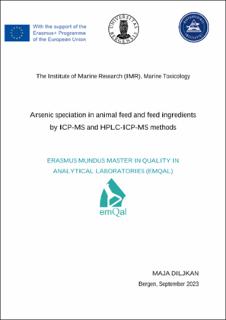Arsenic speciation in animal feed and feed ingredients by ICP-MS and HPLC-ICP-MS methods
Master thesis
Permanent lenke
https://hdl.handle.net/11250/3094688Utgivelsesdato
2023-09-30Metadata
Vis full innførselSamlinger
- Master theses [85]
Utgiver
The University of BergenOpphavsrett
Copyright the Author. All rights reservedBeslektede innførsler
Viser innførsler beslektet ved tittel, forfatter og emneord.
-
Arsenic speciation and arsenic feed-to-fish transfer in Atlantic salmon fed marine low trophic feeds based blue mussel and kelp
Silva, Marta Sofia; Tibon, Jojo; Sartipiyarahmadi, Sahar; Remø, Sofie C.; Sele, Veronika; Søfteland, Liv Ingeborg Rosvoll; Sveier, Harald; Wiech, Martin; Philip, Antony Jesu Prabhu; Berntssen, Marc HG (Journal article; Peer reviewed, 2023)Background: Aquaculture aims to reduce the environmental and climate footprints of feed production. Consequently, low trophic marine (LTM) resources such as blue mussels and kelp are potential candidates to be used as ... -
Replacing fish meal with insect meal in the diet of Atlantic salmon (Salmo salar) does not impact the amount of contaminants in the feed and it lowers accumulation of arsenic in the fillet
Biancarosa, Irene; Sele, Veronika; Belghit, Ikram; Ørnsrud, Robin; Lock, Erik-Jan; Amlund, Heidi (Peer reviewed; Journal article, 2019)Insects are promising sources of protein and lipid in feeds for farmed animals. In the European Union, the use of insect meal (IM) and insect oil is permitted in fish feed. However, the European Food Safety Authority has ... -
Distribution of fat, selenium, mercury, cadmium, arsenic, and persistent organic pollutants in Atlantic Bluefin Tuna (Thunnus thynnus) and implications for sampling and food safety
Øyan, Sigurd Johannes (Master thesis, 2021-10-01)The Atlantic bluefin tuna (ABFT)(Thunnus thynnus) has for a long time been absent off the Norwegian coast, but has started reappearing increasingly in the last decade. The ABFT has both high economic and cultural values, ...
